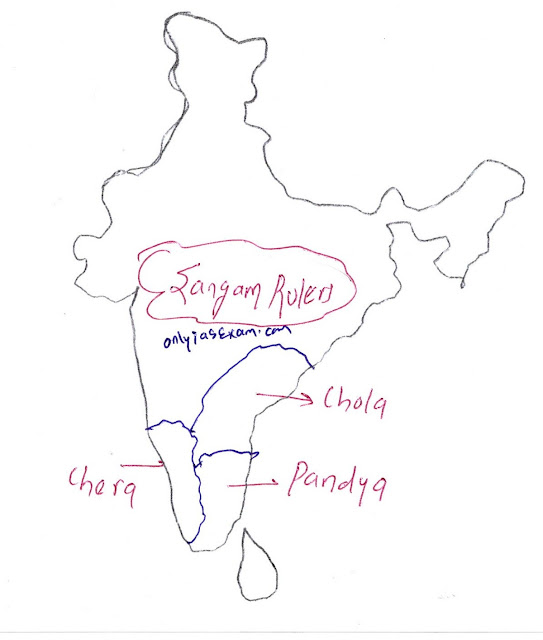Table of Contents:
- About Chola, Chera, and Pandya
- Chera
- Pandya
- Chola
- Tamil Sangam Period ( Early, middle, and later)
Notes on Cheras, Cholas, and Pandyas Dynasty:
The Chera, Chola, and Pandya were three ancient Tamil dynasties that ruled in South India from 300 BC to 300 CE.
The following are some details of the history of each dynasty individually
The Chera:
Chera ruled part of Kerala and part of Tamil Nadu territories.
The capital of Chera was Vanji or Kuruvur, it is located on the bank of Periyar river.
Muziris and Tondi were important port cities as well as trade centers of Cheras.
They built the temple of Augustus at Muziris.
Great King of Chera was Senguttuvan or Red Chera. He invaded north India and even crossed Ganga. He was the founder of the Pattini cult.
They did trade with the Romans. Roman's two regiments were also present at Muziris.
They founded the famous Pattini cult, in which they worship the goddess of Chastity or Kannagi.
The Pandyas:
The Pandya ruled Present Day Tamil Nadu. Mudukumudi was the earlier ruler of Pandya.
Madurai was the capital of the Pandya kingdom.
Megasthenese mentioned the Pandava kingdom as famous for pearls.
Pandya kingdom had traded with the Roman emperor Augustus and Trojans.
The name of the Pandya kingdom was also found in Ramayana and Mahabharata epics.
Pandaya king Nendujelian accused Kovalan of theft. As a result, the wife of Kovalan ( Kannagi) cursed the King and Madurai. It was part of the Tamil epic "Selipatikaram".
The Chola ( Early Chola):
The early Chola kingdom was known as Cholamandalam, which was situated in North East of Pandya Kingdom, between the Pennar and Vellar rivers.
Modern Tanjore and Tiruchirapalli were part of the Cholas kingdom.
The inland capital of Chola was Uraiyur, which was famous for the cotton trade. The alternative capital of Chola was Puhar, which is also known as Kaveripattanam. It is the main port.
Chola king Ealara ( Ellalan) conquered Sri Lanka and ruled for 50 years. The Ellalan king ( 161 BC) also known as "Manu Needhi Cholan".
Karikala won the whole Cylon ( Sri lanka). Karikala ( 190 CE) was the greatest king of Chola, he founded the capital city, Puhar, and he constructed 160 km of embankment along with the Kaveri river with the help of 12000 Sri Lankan slaves. He won the famous battle of Venni in which he defeated Pandya and Chera.
Pallavas defeated the Chola and they wiped them out from the North around 300 CE.
Sangam Literature:
The term " Sangam" refers to assemblies or gatherings of Tamil poets and scholars who met to discuss and compose literary works.
Sangam literature is a collection of ancient Tamil literature, which was composed between the 3rd century BC and the 3rd Century CE in the region known as Tamilakam, which comprises territories of present-day Tamil Nadu, Kerala, and Parts of Sri Lanka.
The Sangam period is divided into three main phases-
- The Early Sangam period
- The Middle Sangam period
- The Late Sangam period
Each phase is characterized by the patronage of different kings and the development of various literary styles.
The Early Sangam period ( 300 BC - 100 CE);
This period composed the oldest works in Tamil literature. Unfortunately, most of the literature from this period has been lost, and only a few fragments are found. The most important work from this period is the Tolkappiyam, a treatise on Tamil Grammar, poetics, and linguistics.
The Middle Sangam period ( 100 CE -300 CE):
The Middle Sangam Period is considered the golden age of Tamil literature. The majority of Sangam anthologies like Ettuthokai and Pattupattu, were composed. These Anthologies include famous collections of poems, such as the Kuruntokai, Natrinai, Akananuru, and Purananuru. These poems cover a wide range of themes, including love, war, nature, and ethics.
The Later Sangam period ( 300 CE - 600 CE):
The later Sangam period witnessed a decline in literary activities, and fewer works were composed compared to the previous periods.
Some notable works from this period include the Pathitrupathu, a collection of ten idylls, and the Pattinapalai, a poem that describes the city of Madurai and its ruler.
Sangam's poems highlight the importance of morality, love, and righteousness. Sangal literature provides valuable insights into the social, cultural, and economic conditions of ancient Tamil society.
Overall, Sangam Literature is an important cultural heritage of Tamil Nadu and has played a significant role in shaping Tamil identity and language. It continues to be studied and celebrated for its literary excellence and historical values.
You may like also:

ConversionConversion EmoticonEmoticon